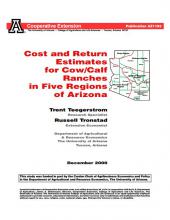Cost and Return Estimates for Cow/Calf Ranches in Five Regions of Arizona

The dependency of Arizona ranchers on federal lands has been well documented. Mayes and Archer (1982) estimated that public and state grazing lands outside of the Indian reservations account for 85% of the total grazing land in Arizona. The partnership between private ranchers, state lands, and the federal government comes with many complex factors that influence the cost of doing business both in terms of variable costs and fixed costs. Not only are the regulations, fees, and enforcement of regulations a challenge for managing mixed land ownership, but additional costs from vandalism, theft, and daily disruptions of operations add to the normal operating expenses (Ruyle et al., 2000). Ownership and maintenance of range improvements, such as wells, spring development, and dirt tanks, etc., is also complicated by the rangeland ownership mix. This study is designed to examine the cost of ranching in various areas in Arizona and how different production costs can be throughout the state.
This study looks at the cost and return estimates for typical cow/calf operations in each of the five ranching regions of Arizona (see page 9). Each region was developed based on the typical land ownership pattern associated with an average cow/calf operation within the region. Once the typical ownership patterns were defined and the boundaries were drawn, other characteristics were developed to describe each
region. Land ownership is defined by the percentage of federal (BLM & USFS), state, and private lands grazed by the ranch operation in any given year.

